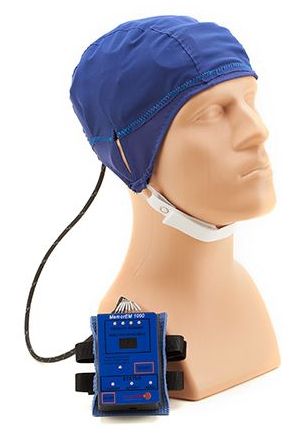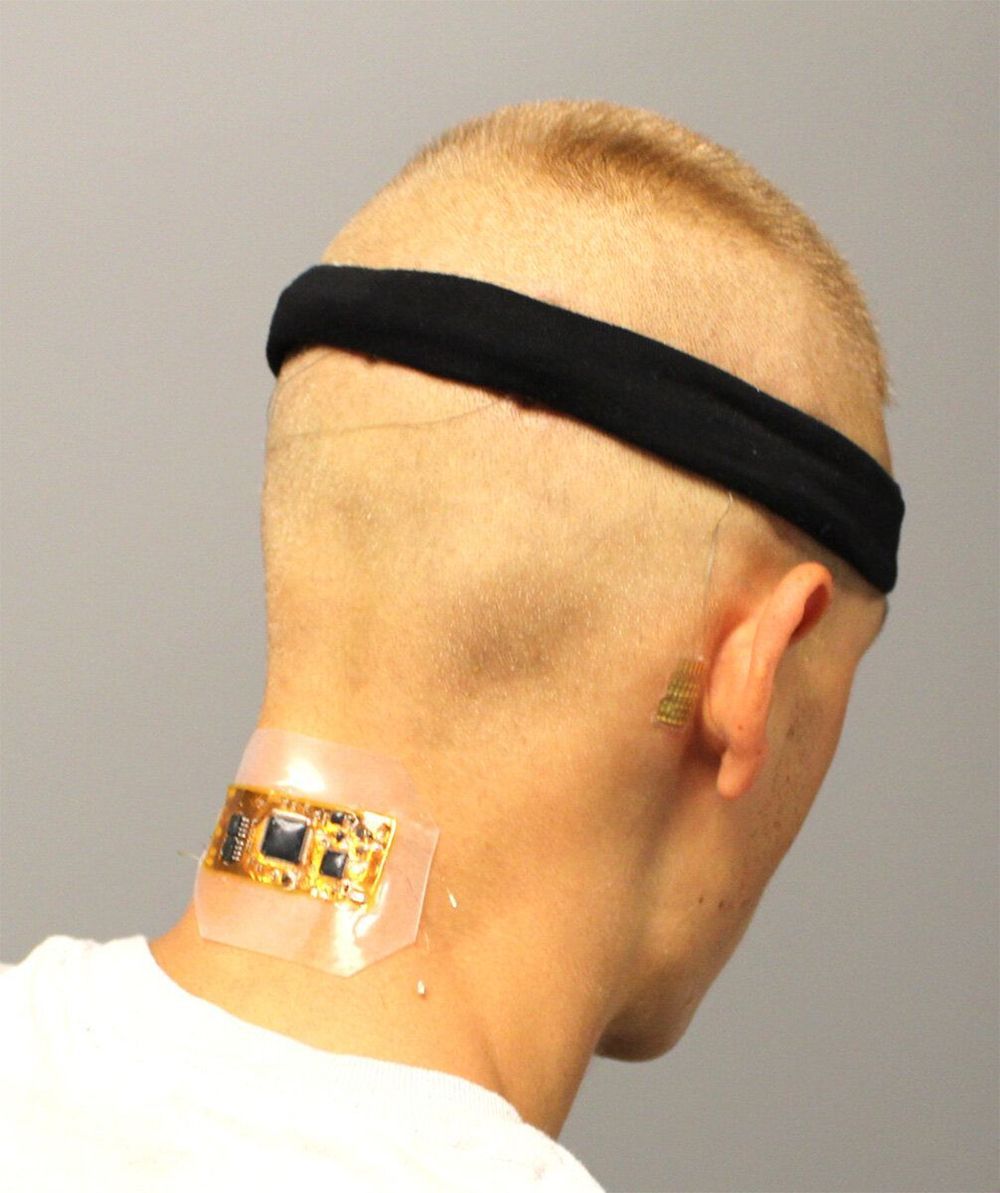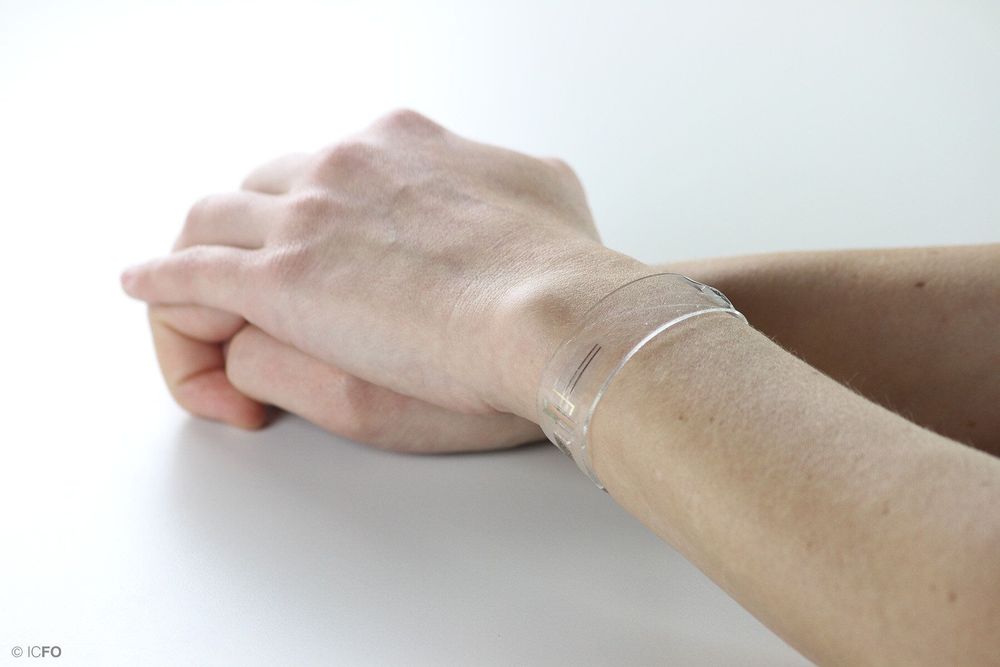This wearable gill could help you breathe underwater.
Category: wearables – Page 63

New Shape-Morphing, Self-Healing, Intelligent Material Developed for Soft Robotics
Advances in the fields of soft robotics, wearable technologies, and human/machine interfaces require a new class of stretchable materials that can change shape adaptively while relying only on portable electronics for power. Researchers at Carnegie Mellon University have developed such a material that exhibits a unique combination of high electrical and thermal conductivity with actuation capabilities that are unlike any other soft composite.
In findings published in Proceedings of the National Academy of Sciences this week, the researchers report on this intelligent new material that can adapt its shape in response to its environment. The paper is titled “A multifunctional shape-morphing elastomer with liquid metal inclusions.”
“It is not only thermally and electrically conductive, it is also intelligent,” said Carmel Majidi, an associate professor of mechanical engineering who directs the Soft Machines Lab at Carnegie Mellon. “Just like a human recoils when touching something hot or sharp, the material senses, processes, and responds to its environment without any external hardware. Because it has neural-like electrical pathways, it is one step closer to artificial nervous tissue.”

Flexible, wearable supercapacitors based on porous nanocarbon nanocomposites
Evening gowns with interwoven LEDs may look extravagant, but the light sources need a constant power supply from devices that are as well wearable, durable, and lightweight. Chinese scientists have manufactured fibrous electrodes for wearable devices that are flexible and excel by their high energy density. Key for the preparation of the electrode material was a microfluidic technology, as shown in the journal Angewandte Chemie.
Dresses emitting sparkling light from hundreds of small LEDs may create eye-catching effects in ballrooms or on fashion shows. But wearable electronics can also mean sensors integrated in functional textiles to monitor, for example, water evaporation or temperature changes. Energy storage systems powering such wearable devices must combine deformability with high capacity and durability. However, deformable electrodes often fail in long-term operation, and their capacity lags behind that of other state-of-the-art energy storage devices.
Electrode materials usually benefit from a fine balance of porosity, conductivity, and electrochemical activity. Material scientists Su Chen, Guan Wu, and their teams from Nanjing Tech University, China, have looked deeper into the material demands for flexible electrodes and developed a porous hybrid material synthesized from two carbon nanomaterials and a metal-organic framework. The nanocarbons provided the large surface area and excellent electrical conductivity, and the metal-organic framework gave the porous structure and the electrochemical activity.


This new wearable tech is closing the gap between humans and cyborgs
A professor at the University of Chicago believes he is on his way to creating a wearable for market that will manipulate your muscles with electrical impulses to cause you to move involuntarily so you can perform a physical task you otherwise didn’t know how to do, like playing a musical instrument or operating machinery.
Dr. Pedro Lopes, who heads the Human Computer Integration lab at the university, is all about integrating humans and computers, closing the gap between human and machine. His team, which focuses on engineering the next generation of wearable and haptic devices, is exploring the endless possibilities if wearables could intentionally share parts of our body for input and output, allowing computers to be more directly interwoven in our bodily senses and actuators.
Lopes’ vision: a wearable EMS device that would look like a sleeve and be able to send electrical impulses in the right timing and in the right fashion to make a user’s muscles move involuntarily to perform a physical task. EMS stands for electrical muscle stimulation.

Alzheimer’s symptoms reversed by head-worn device using electromagnetic waves
A small clinical trial, announced by U.S. company NeuroEM Therapeutics, shows reversal of cognitive impairment in Alzheimer’s disease patients after just two months of treatment using a wearable head device. Electromagnetic waves emitted by the device appear to penetrate the brain to break up amyloid-beta and tau deposits.
Goodbye, Motherboard. Hello, Silicon-Interconnect Fabric
The need to make some hardware systems tinier and tinier and others bigger and bigger has been driving innovations in electronics for a long time. The former can be seen in the progression from laptops to smartphones to smart watches to hearables and other “invisible” electronics. The latter defines today’s commercial data centers—megawatt-devouring monsters that fill purpose-built warehouses around the world. Interestingly, the same technology is limiting progress in both arenas, though for different reasons.
The culprit, we contend, is the printed circuit board. And the solution is to get rid of it.
Our research shows that the printed circuit board could be replaced with the same material that makes up the chips that are attached to it, namely silicon. Such a move would lead to smaller, lighter-weight systems for wearables and other size-constrained gadgets, and also to incredibly powerful high-performance computers that would pack dozens of servers’ worth of computing capability onto a dinner-plate-size wafer of silicon.

Wearable brain-machine interface could control a wheelchair, vehicle or computer
Combining new classes of nanomembrane electrodes with flexible electronics and a deep learning algorithm could help disabled people wirelessly control an electric wheelchair, interact with a computer or operate a small robotic vehicle without donning a bulky hair-electrode cap or contending with wires.
By providing a fully portable, wireless brain-machine interface (BMI), the wearable system could offer an improvement over conventional electroencephalography (EEG) for measuring signals from visually evoked potentials in the human brain. The system’s ability to measure EEG signals for BMI has been evaluated with six human subjects, but has not been studied with disabled individuals.
The project, conducted by researchers from the Georgia Institute of Technology, University of Kent and Wichita State University, was reported on September 11 in the journal Nature Machine Intelligence.

New health monitors are flexible, transparent and graphene enabled
New technological devices are prioritizing non-invasive tracking of vital signs, not only for fitness monitoring, but also for the prevention of common health problems such as heart failure, hypertension and stress-related complications, among others. Wearables based on optical detection mechanisms are proving an invaluable approach for reporting on our bodies inner workings and have experienced a large penetration into the consumer market in recent years. Current wearable technologies, based on non-flexible components, do not deliver the desired accuracy and can only monitor a limited number of vital signs. To tackle this problem, conformable non-invasive optical-based sensors that can measure a broader set of vital signs are at the top of the end-users’ wish list.
In a recent study published in Science Advances, ICFO researchers have demonstrated a new class of flexible and transparent wearable devices that are conformable to the skin and can provide continuous and accurate measurements of multiple human vital signs. These devices can measure heart rate, respiration rate and blood pulse oxygenation, as well as exposure to UV radiation from the sun. While the device measures the different parameters, the read-out is visualized and stored on a mobile phone interface connected to the wearable via Bluetooth. In addition, the device can operate battery-free since it is charged wirelessly through the phone.
“It was very important for us to demonstrate the wide range of potential applications for our advanced light sensing technology through the creation of various prototypes, including the flexible and transparent bracelet, the health patch integrated on a mobile phone and the UV monitoring patch for sun exposure. They have shown to be versatile and efficient due to these unique features,” reports Dr. Emre Ozan Polat, first author of this publication.

New Wearable Device Could Accurately Detect Cancer

Biopsies are currently the best way to detect cancer, but they’re invasive, uncomfortable, and can take a while to come back. Researchers have long been trying to find ways to eliminate the need for biopsies, and a team from the University of Michigan may have found one. Their new device, which is currently being tested, may be able to detect cancer cells that are circulating in a patient’s blood.
The University of Michigan team calls their new device “the epitome of precision medicine.” Dr. Daniel Hayes, Professor of Breast Cancer Research at the University of Michigan Rogel Cancer center, believes that getting cancer cells from a patient’s blood could help researchers to learn more about the makeup of the tumor. He and his team created a wearable device that looks through the blood to filter out cancerous cells. If the device is found to be successful, it may eventually replace liquid biopsies (blood or urine samples) that pick up cancer markers.
 Malignant tumors release cells into a patient’s blood, meaning that researchers could detect the presence of cancer through a blood sample. The problem is that the cancerous cells enter the bloodstream and circulate so quickly that they may not appear in one single blood sample. This issue is what sparked Dr. Hayes and his team to develop a device that actually searches for the cancerous cells.
Malignant tumors release cells into a patient’s blood, meaning that researchers could detect the presence of cancer through a blood sample. The problem is that the cancerous cells enter the bloodstream and circulate so quickly that they may not appear in one single blood sample. This issue is what sparked Dr. Hayes and his team to develop a device that actually searches for the cancerous cells.